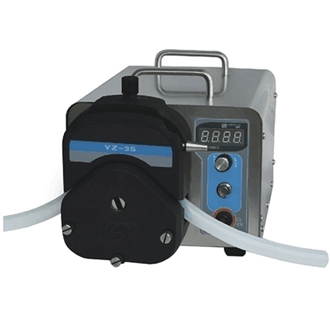What is a Peristaltic Pump?
A peristaltic pump, often referred to as a hose pump, is a type of positive displacement pump used in various industries, including laboratories, pharmaceuticals, healthcare, and chemical processing. Peristaltic pumps achieve fluid transfer by compressing and releasing a flexible hose, making them well-suited for applications that demand precision and the handling of corrosive or viscous liquids.

The operating principle of a peristaltic pump involves the compression and release of a flexible hose to create a pulsating flow of fluid. As the hose is squeezed, fluid is forced to move within the tube. When the squeezing action is released, more fluid is drawn into the hose. This phenomenon of fluid movement within the hose resembles the peristaltic motion of the human gastrointestinal system, hence the name "peristaltic pump."
A complete peristaltic pump system typically includes a control system, an electric motor, and a pump head. The pump head contains a flexible hose and a roller mechanism. The rotation of the roller mechanism drives the fluid within the hose. The control system adjusts the flow rate and direction by changing the motor's speed and direction. Multiple rollers apply pressure to the hose, creating a vacuum in the tube, which propels the fluid forward.
Peristaltic pumps offer several advantages:
- They can handle fluids with entrapped air.
- They apply low shear forces, making them suitable for shear-sensitive, oxidation-prone, and abrasive fluids.
- They can accommodate solid particles up to 40% of the inner tube diameter.
- They have only one contact part, the hose, which can be easily replaced, simplifying cleaning and disinfection.
- They offer high precision, self-priming capabilities, and bidirectional equal flow rates.
- They do not damage any pump components in case of dry running, and they can achieve up to 98% vacuum levels.
One notable feature of peristaltic pumps is that they do not require cleaning because the fluid only comes into contact with the pump tube, which is easily cleaned and disinfected. Additionally, peristaltic pumps prevent backflow and siphoning, ensuring high accuracy in fluid transfer.
However, there are some drawbacks to consider:
- The pump hose may deteriorate over time and require periodic replacement.
- Peristaltic pumps may have limitations in terms of pressure and may not provide continuous and stable flow rates.
- The use of a flexible hose can result in lower pump speeds and increased vibrations.
- The flow range is relatively narrow.
Maintenance and Care:
- The maintenance of peristaltic pumps is straightforward, making it one of their key features:
- The roller shafts should be lubricated regularly to maintain smooth operation. Check the roller shaft's tightness during lubrication. If there is excessive looseness, use needle-nose pliers to tighten it. If the roller shaft remains loose after adjustment, consider inspecting the inner bearings for wear or replacing the roller shaft.
- The roller shaft bearings should be greased approximately every six months.
When using a new gearbox, drain the oil and refill it with 30# oil after a certain period of operation.
The low maintenance and ease of hose replacement are factors that contribute to the cost-effectiveness of peristaltic pumps. Compared to other pump types, peristaltic pumps can save significant operational costs. While maintenance and repair of other pumps can take five to six hours, peristaltic pumps only require hose replacement. Moreover, they are convenient for liquid transfer, allowing the choice of different-priced pump tubes for various fluid types.
Peristaltic pumps have a relatively long maintenance cycle, requiring maintenance approximately once every six months under normal operating conditions. If you want to know more about the peripheral pump, please visit the ATO.com.

